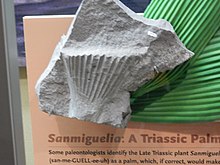
Monocotyledons, commonly referred to as monocots, are grass and grass-like flowering plants (angiosperms), the seeds of which typically contain only one embryonic leaf, or cotyledon. They constitute one of the major groups into which the flowering plants have traditionally been divided; the rest of the flowering plants have two cotyledons and are classified as dicotyledons, or dicots.

Gnetophyta is a division of plants, grouped within the gymnosperms, that consists of some 70 species across the three relict genera: Gnetum, Welwitschia, and Ephedra. The earliest unambiguous records of the group date to the Jurassic, and they achieved their highest diversity during the Early Cretaceous. The primary difference between gnetophytes and other gymnosperms is the presence of vessel elements, a system of small tubes (xylem) that transport water within the plant, similar to those found in flowering plants. Because of this, gnetophytes were once thought to be the closest gymnosperm relatives to flowering plants, but more recent molecular studies have brought this hypothesis into question, with many recent phylogenies finding them to be nested within the conifers.
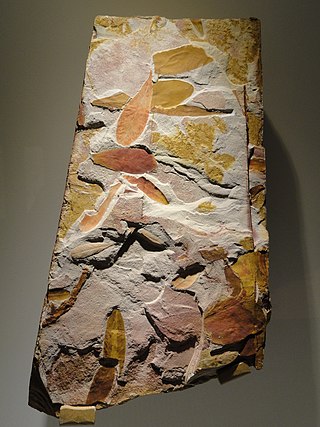
Glossopteris is the largest and best-known genus of the extinct Permian order of seed plants known as Glossopteridales. The genus Glossopteris refers only to leaves, within a framework of form genera used in paleobotany. Species of Glossopteris were the dominant trees of the middle to high-latitude lowland vegetation across the supercontinent Gondwana during the Permian Period. Glossopteris fossils were critical in recognizing former connections between the various fragments of Gondwana: South America, Africa, India, Australia, New Zealand, and Antarctica.

Bennettitales is an extinct order of seed plants that first appeared in the Permian period and became extinct in most areas toward the end of the Cretaceous. Bennettitales were amongst the most common seed plants of the Mesozoic, and had morphologies including shrub and cycad-like forms. The foliage of bennettitaleans is superficially nearly indistinguishable from that of cycads, but they are distinguished from cycads by their more complex flower-like reproductive organs, at least some of which were likely pollinated by insects.

Williamsonia is a genus of plant belonging to Bennettitales, an extinct order of seed plants. Within the form classification system used in paleobotany, Williamsonia is used to refer to female seed cones, which are associated with plants that also bore the male flower-like reproductive structure Weltrichia.
A strobilus is a structure present on many land plant species consisting of sporangia-bearing structures densely aggregated along a stem. Strobili are often called cones, but some botanists restrict the use of the term cone to the woody seed strobili of conifers. Strobili are characterized by a central axis surrounded by spirally arranged or decussate structures that may be modified leaves or modified stems.

Archaeamphora longicervia is a fossil plant species, the only member of the hypothetical genus Archaeamphora. Fossil material assigned to this taxon originates from the Yixian Formation of northeastern China, dated to the Early Cretaceous.

Cheirolepidiaceae is an extinct family of conifers. They first appeared in the Triassic, and were widespread during most of the Mesozoic era. They are united by the possession of a distinctive pollen type assigned to the form genus Classopollis. The name Frenelopsidaceae or "frenelopsids" has been used for a group of Cheirolepidiaceae with jointed stems, thick internode cuticles, sheathing leaf bases and reduced free leaf tips. The leaf morphology has been noted as being similar to that of halophyte Salicornia. Several members of the family appear to have been adapted for semi-arid and coastal settings, with a high tolerance of saline conditions. Cheirolepidiaceae disappeared from most regions of the world during the Cenomanian-Turonian stages of the Late Cretaceous, but reappeared in South America during the Maastrichtian, the final stage of the Cretaceous, increasing in abundance after the K-Pg extinction and being a prominent part of the regional flora during the Paleocene, before going extinct.
This page provides a glossary of plant morphology. Botanists and other biologists who study plant morphology use a number of different terms to classify and identify plant organs and parts that can be observed using no more than a handheld magnifying lens. This page provides help in understanding the numerous other pages describing plants by their various taxa. The accompanying page—Plant morphology—provides an overview of the science of the external form of plants. There is also an alphabetical list: Glossary of botanical terms. In contrast, this page deals with botanical terms in a systematic manner, with some illustrations, and organized by plant anatomy and function in plant physiology.
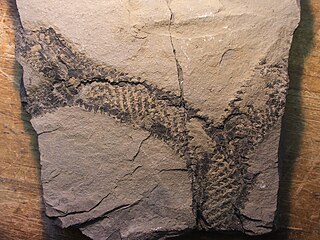
Lepidodendrales or arborescent lycophytes are an extinct order of primitive, vascular, heterosporous, arborescent (tree-like) plants belonging to Lycopodiopsida. Members of Lepidodendrales are the best understood of the fossil lycopsids due to the vast diversity of Lepidodendrales specimens and the diversity in which they were preserved; the extensive distribution of Lepidodendrales specimens as well as their well-preservedness lends paleobotanists exceptionally detailed knowledge of the coal-swamp giants’ reproductive biology, vegetative development, and role in their paleoecosystem. The defining characteristics of the Lepidodendrales are their secondary xylem, extensive periderm development, three-zoned cortex, rootlike appendages known as stigmarian rootlets arranged in a spiralling pattern, and megasporangium each containing a single functional megaspore that germinates inside the sporangium. Many of these different plant organs have been assigned both generic and specific names as relatively few have been found organically attached to each other. Some specimens have been discovered which indicate heights of 40 and even 50 meters and diameters of over 2 meters at the base. The massive trunks of some species branched profusely, producing large crowns of leafy twigs; though some leaves were up to 1 meter long, most were much shorter, and when leaves dropped from branches their conspicuous leaf bases remained on the surface of branches. Strobili could be found at the tips of distal branches or in an area at the top of the main trunk. The underground organs of Lepidodendrales typically consisted of dichotomizing axes bearing helically arranged, lateral appendages serving an equivalent function to roots. Sometimes called "giant club mosses", they are believed to be more closely related to extant quillworts based on xylem, although fossil specimens of extinct Selaginellales from the Late Carboniferous also had secondary xylem.
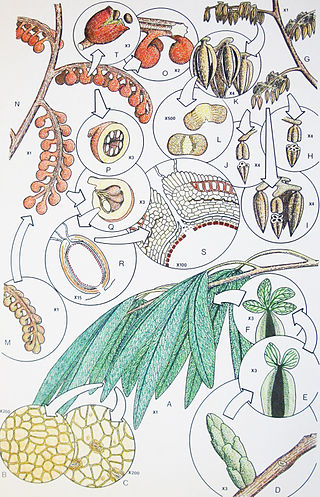
The Caytoniales are an extinct order of seed plants known from fossils collected throughout the Mesozoic Era, around 252 to 66 million years ago. They are regarded as seed ferns because they are seed-bearing plants with fern-like leaves. Although at one time considered angiosperms because of their berry-like cupules, that hypothesis was later disproven. Nevertheless, some authorities consider them likely ancestors or close relatives of angiosperms. The origin of angiosperms remains unclear, and they cannot be linked with any known seed plants groups with certainty.

Sagenopteris is a genus of extinct seed ferns from the Triassic to late Early Cretaceous.

Dicroidium is an extinct genus of fork-leaved seed plants. It is the archetypal genus of the corystosperms, an extinct group of seed plants, often called "seed ferns", assigned to the order Corystospermales or Umkomasiales. Species of Dicroidium were widely distributed and dominant over Gondwana during the Triassic. Their fossils are known from South Africa, the Arabian Peninsula, Australia, New Zealand, South America, Madagascar, the Indian subcontinent and Antarctica.

The Peltaspermales are an extinct order of seed plants, often considered "seed ferns". They span from the Late Carboniferous to the Early Jurassic. It includes at least one valid family, Peltaspermaceae, which spans from the Permian to Early Jurassic, which is typified by a group of plants with Lepidopteris leaves, Antevsia pollen-organs, and Peltaspermum ovulate organs, though the family now also includes other genera like Peltaspermopsis, Meyenopteris and Scytophyllum. Along with these, two informal groups of uncertain taxonomic affinities exist, each centered around a specific genus ; Supaia and Comia, known from the Early Permian of the Northern Hemisphere, especially of North America. Both the "Comioids" and the "Supaioids" are associated with the peltaspermacean ovulate organ Autunia. The Late Triassic-Middle Jurassic genus Pachydermophyllum may also have affinities to the peltasperms.

Corystosperms are a group of extinct seed plants belonging to the family Corystospermaceae assigned to the order Corystospermales or Umkomasiales. They were first described based on fossils collected by Hamshaw Thomas from the Burnera Waterfall locality near the Umkomaas River of South Africa. Corystosperms are typified by a group of plants that bore forked Dicroidium leaves, Umkomasia cupulate ovulate structures and Pteruchus pollen organs, which grew as trees that were widespread over Gondwana during the Middle and Late Triassic. Other fossil Mesozoic seed plants with similar leaf and/or reproductive structures have also sometimes been included within the "corystosperm" concept sensu lato, such as the "doyleoids" from the Early Cretaceous of North America and Asia. A potential corystosperm sensu lato, the leaf genus Komlopteris, is known from the Eocene of Tasmania, around 53-50 million years old, over 10 million years after the Cretaceous–Paleogene extinction event.
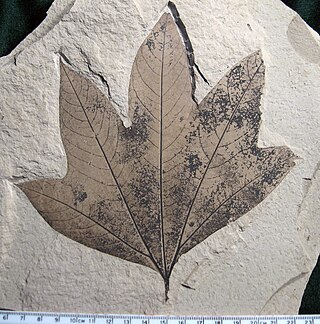
Macginitiea is an extinct genus in the family Platanaceae ranging from the Late Paleocene to Late Eocene of North America, known from the Clarno Formation of central Oregon. The genus is strictly used to describe leaves, but has been found in close association with other fossil platanoid organs, which collectively have been used for whole plant reconstructions. Macginitiea and its associated organs are important as together they comprise one of the most well-documented and ubiquitous fossil plants, particularly in the Paleogene of North America.
This article records new taxa of plants that are scheduled to be described during the year 2018, as well as other significant discoveries and events related to paleobotany that occurred in the year 2018.
Eucommiidites is an angiosperm look-alike pollen type from the Mesozoic Era. When it was first described in Sweden, it was thought to represent pollen from the earliest angiosperms. However, it was subsequently shown, due to morphology, that it could not be angiospermous. Later, Eucommidites pollen was discovered in the pollen chambers of fossil gymnosperm seeds. It was later shown to be the pollen of the extinct gymnosperm order Erdtmanithecales, suggested to have close affinities with Bennettitales and Gnetales.
Pentoxylales is an extinct order of seed plants known from the Jurassic and Early Cretaceous of East Gondwana.
This paleobotany list records new fossil plant taxa that were to be described during the year 2023, as well as notes other significant paleobotany discoveries and events which occurred during 2023.
